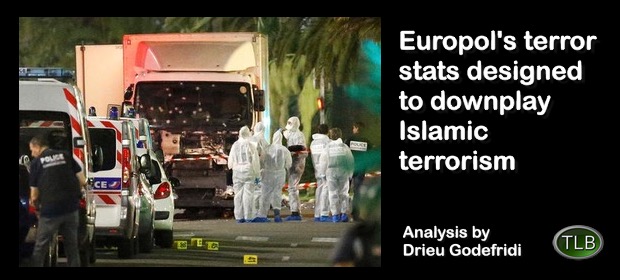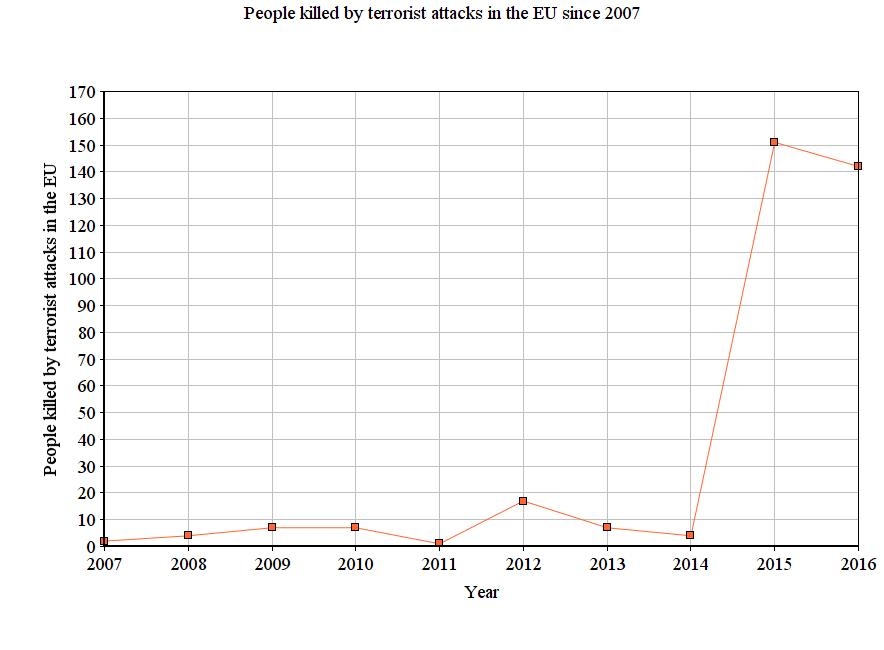
Terrorism in Europe
DRIEU GODEFRIDI
- The problem, of course, resides in the European definition of terrorism. The EU definition of terrorism, wittingly or unwittingly, confuses the issue. It needs to be revised.
- Under the definition of terrorism in American law (18 U.S. Code § 2331), no act can be qualified as terrorist if there is no terror intended.
Terrorism is booming in Europe — even though the European Union statistics say it is not. The EU’s statistics on terrorism, simply put, confuse the issue. They are a fairy-tale.
Since 9/11, in report after report, experts, ministers and public authorities have been saying the same thing: that in Europe (meaning the EU), Islamic terrorism is merely a marginal aberration. Nothing to be afraid of, and if you show too much interest in the matter you are probably on the far-right, aren’t you! Do you want to persecute the Muslims and make them the Jews of today’s Europe?
As experts always do when they want to shut down a debate, they turn to statistics, preferably European statistics. Since July 1, 1999 — the date of its inception — Europol (European Union Agency for Law Enforcement Cooperation) has regularly published an assessment of terrorism in the EU.

Europol headquarters in The Hague, Netherlands. (Image source: OSeveno/Wikimedia Commons) |
If you read Europol’s last ten EU Terrorism Situation and Trend Reports (TE-SAT), you will find, year after year, the number of “failed, foiled or successfully executed” terror attacks and the subsequent number of victims — all you supposedly need to assess the true nature of terrorism in the EU.
For the number of terror attacks in Europe during the last ten years, here is a chart based on Europol’s data:
 Number of terror or terrorist attacks in the EU since 2007 (Data: EU Terrorism Situation and Trend Reports; chart D. Godefridi) Number of terror or terrorist attacks in the EU since 2007 (Data: EU Terrorism Situation and Trend Reports; chart D. Godefridi) |
The first surprise is that according to Europol, the trend is clearly downward: far fewer terror attacks in Europe in 2016 than ten years ago!
Does that seem a bit counter-intuitive? But, hey, those are the official statistics.
Then there are the number of fatalities:
 People killed by terror attacks in the EU since 2007 (Data: EU Terrorism Situation and Trend Reports; chart D. Godefridi) People killed by terror attacks in the EU since 2007 (Data: EU Terrorism Situation and Trend Reports; chart D. Godefridi) |
This second chart looks much more in line with the feelings of the common man, don’t you think? Approximately 150 dead in the EU from terror attacks in 2015 and 2016, compared to zero in 2007, or 4 in 2014. (That is what is so endearing about statistics: you can manipulate many things, such as the psychological and emotional damage or the consequences of a “foiled attack” — but not the number of dead bodies).
If you superimpose the two preceding charts, there is, obviously, zero correlation between the number of attacks and the number of dead. Even if there are fewer attacks, more people are being killed. In 2007, there were 583 attacks but zero people killed. In 2016, there were 142 attacks with 142 killed.

Terror attacks and people killed by terror attacks in the EU since 2007 (Data: EU Terrorism Situation and Trend Reports; chart D. Godefridi) |
Where is the wolf? The problem resides in the European definition of terrorism. Look at the TE-SAT report of 2009:
“What the term ‘terrorist offences’ includes is indicated in Article 1 of the Council Framework Decision of 13 June 2002 on combating terrorism (2002/475/JHA), which all member states have implemented in their national legislation. This Framework Decision specifies that terrorist offences are intentional acts which, given their nature or context, may seriously damage a country or an international organisation when —
- committed with the aim of seriously intimidating a population, or
- unduly compelling a government or international organisation to perform or abstain from performing an act, or
- seriously destabilising or destroying the fundamental political, constitutional, economic or social structures of a country or an international organisation”.
On this legal basis, Europol distinguishes between different categories of terror attacks: jihadist terrorism; ethno-nationalist and separatist terrorism; left-wing and anarchist terrorism; right-wing terrorism; and finally, “single issue terrorism” (such as animal rights).
There is nothing wrong with these definitions except that one thing has gotten lost: terror…
ER recommends other articles by The Gatestone Institute
About the author
Drieu Godefridi, a classical-liberal Belgian author, is the founder of the l’Institut Hayek in Brussels. He has a PhD in Philosophy from the Sorbonne in Paris and also heads investments in European companies.
[1] “The term “domestic terrorism” means activities that— (A) involve acts dangerous to human life that are a violation of the criminal laws of the United States or of any State; (B) appear to be intended— (i) to intimidate or coerce a civilian population; (ii) to influence the policy of a government by intimidation or coercion; or (iii) to affect the conduct of a government by mass destruction, assassination, or kidnapping.”




